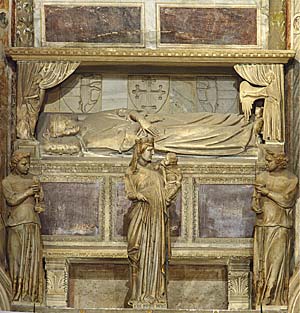 |
 |
| Enrico Scrovegni, who commissioned the Chapel,
portrayed by Giotto as he offers up the model of the Chapel to the
Virgin, the Last Judgement, Scrovegni Chapel, Padua |
 |
Declared and hidden
intentions
It is thought that the main reason why Enrico Scrovegni
decided to erect the Chapel was his fervid desire to save the soul of
his father Reginaldo from the pains of everlasting damnation incurred
after a life spent as a notorious usurer. At the same time, Enrico was
hoping to ward off a similar fate for himself since he too was tainted
with the same "sin", though to a lesser degree.
Confirmation of this can be seen in the scene showing the dedication of
the Chapel to the Virgin, a symbolic gesture in which he hands back the
ill-gotten gains of usury - an act required by the Church in order to
earn remission of the sin. Other indications are the large number of usurers
depicted in the scene representing the Inferno, the dangling corpse of
Judas face to face with Judas receiving the thirty pieces of money, and
the allegorical figure of Envy.
Returning to the scene of the dedication, we can see that Enrico
is clothed in purple (the colour of penitence), but has himself placed
in the area set aside for the blessed, beneath the protecting image of
the cross; what's more, he was a member of the Order of the Friars of
Our Lady whose main duty, apart from devotion to the Virgin Mary, was
the fight against usury.
Right from the outset, however, Enrico had another intention, more "private"
and
less edifying but, on the other hand, more "utilitarian"
- to build himself a funeral chapel, as can perhaps be deduced from the
vaulted roof simulating the star-studded sky, which is very similar in
design to sepulchral monuments in Ravenna dating from the paleo-Christian
era. Since the Chapel was directly connected to the main house, this use
seems to be a natural function. Even while Enrico was still alive, the
Chapel was used several times for its funerary purpose - not only is Enrico's
wife buried there, but also two of his nephews - and it kept this function
for many years. Eventually, however, the public
aspect prevailed over its original "private" purpose. This
double function is clearly reflected in Giotto's wall paintings and can
be seen in the complexity of the way in which the cycle is organised,
practically encircling the observer.
 |
|
Enrico Scrovegni's
funeral monument, Scrovegni Chapel, Padua
|
 |
Diverse spaces and views
This double function is also reflected in the subdivision of the space
within the Chapel, whose forward part, up to the two side altars, was
for the congregation, and the other smaller area, between the altars and
the main arch, for the Scrovegni family (while the presbytery was for
the priest and his helpers). Access to the former was from the square
outside through the main door in the facade, for the general public; to
the latter, through a smaller door at the end of the northern wall which
communicated directly with the family's palazzo. The presence of the allegorical
figures on the front of the architrave of the side door shows that the
spiritual "path" from this point is rather different from that
for people coming in through the main door. Of course, the difference
has to do with the depth of meaning that observers are able to perceive.
|












